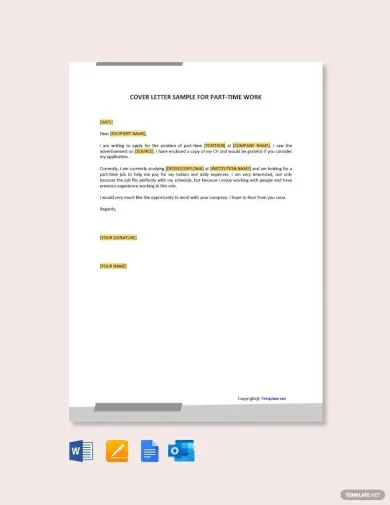Understanding the Importance of a Cover Letter
In the competitive landscape of part-time job applications, a well-crafted cover letter can be your golden ticket to securing an interview. Often overlooked, a cover letter serves as your first introduction to a potential employer, providing an opportunity to go beyond the confines of your resume and showcase your personality, enthusiasm, and unique qualifications. It’s a chance to make a strong first impression and persuade the hiring manager that you are the ideal candidate for the role. A compelling cover letter isn’t just a formality; it’s a strategic tool that can significantly increase your chances of landing the job. Remember, many hiring managers read cover letters first, so this is your opportunity to shine.
Why a Cover Letter Matters for Part-Time Jobs
While the resume presents your qualifications in a concise format, the cover letter allows you to elaborate on your skills and experiences, tailoring them specifically to the requirements of the part-time job. It allows you to demonstrate your understanding of the company, the role, and how your skills align with their needs. This is particularly important for part-time roles, where employers often seek candidates who are a good fit culturally and can efficiently contribute to the team during limited hours. A well-written cover letter provides context to your resume, explaining gaps in your work history, highlighting relevant experiences, and expressing your genuine interest in the position and the company. It allows you to show your personality and enthusiasm, which can be a deciding factor, especially for part-time positions where a good attitude and work ethic are highly valued.
Highlighting Relevant Skills and Experience
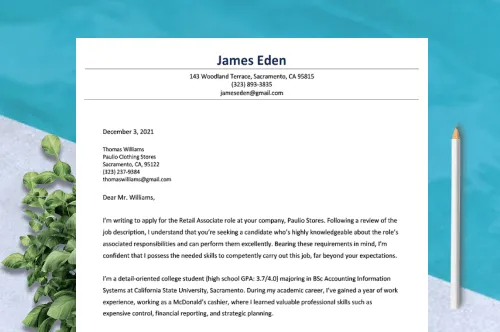
When applying for a part-time job, it is crucial to emphasize the skills and experiences that directly align with the job description. Begin by carefully reviewing the job posting and identifying the key skills and qualifications the employer is seeking. Next, analyze your own background and pinpoint the instances where you have demonstrated these skills. Whether it’s customer service experience from a previous retail job or organizational skills gained through volunteer work, make sure to clearly and concisely highlight these relevant experiences in your cover letter. Use action verbs to describe your accomplishments and quantify your achievements whenever possible. For example, instead of saying “Managed social media,” you could write “Increased social media engagement by 20% through strategic content creation and scheduling.” This shows a tangible benefit you brought to a previous role.
Identifying Transferable Skills for Part-Time Roles
Part-time jobs often require a diverse set of skills, and you may have these even without direct experience in the field. Transferable skills are those you’ve gained in one setting (e.g., school, volunteer work, or previous jobs) that can be applied in another. Common examples include communication, teamwork, time management, problem-solving, and adaptability. Identify these skills in your cover letter by providing specific examples of how you’ve used them in the past. For example, if you’re applying for a customer service role, describe a time you successfully resolved a conflict or assisted a customer. If you’re seeking a role that requires teamwork, provide an example of a successful group project where you demonstrated collaborative skills. Highlighting transferable skills is particularly beneficial if you lack direct experience in the field.
Showcasing Experience in a Compelling Way
Beyond simply listing your experiences, a compelling cover letter brings them to life. Use the STAR method (Situation, Task, Action, Result) to structure your descriptions. Begin by setting the scene (Situation), then describe the task you were assigned (Task). Explain the actions you took to address the task (Action), and finally, share the outcome or results of your efforts (Result). For instance, if you’re highlighting your experience as a cashier, you might describe a challenging customer situation, the steps you took to resolve it (e.g., remaining calm, seeking assistance, offering a solution), and the positive outcome (e.g., customer satisfaction, successful transaction). This narrative approach makes your experiences more memorable and demonstrates your ability to handle real-world scenarios effectively. Always quantify your achievements whenever possible and focus on how your past experiences make you a valuable asset.
Tailoring Your Cover Letter to the Job Description
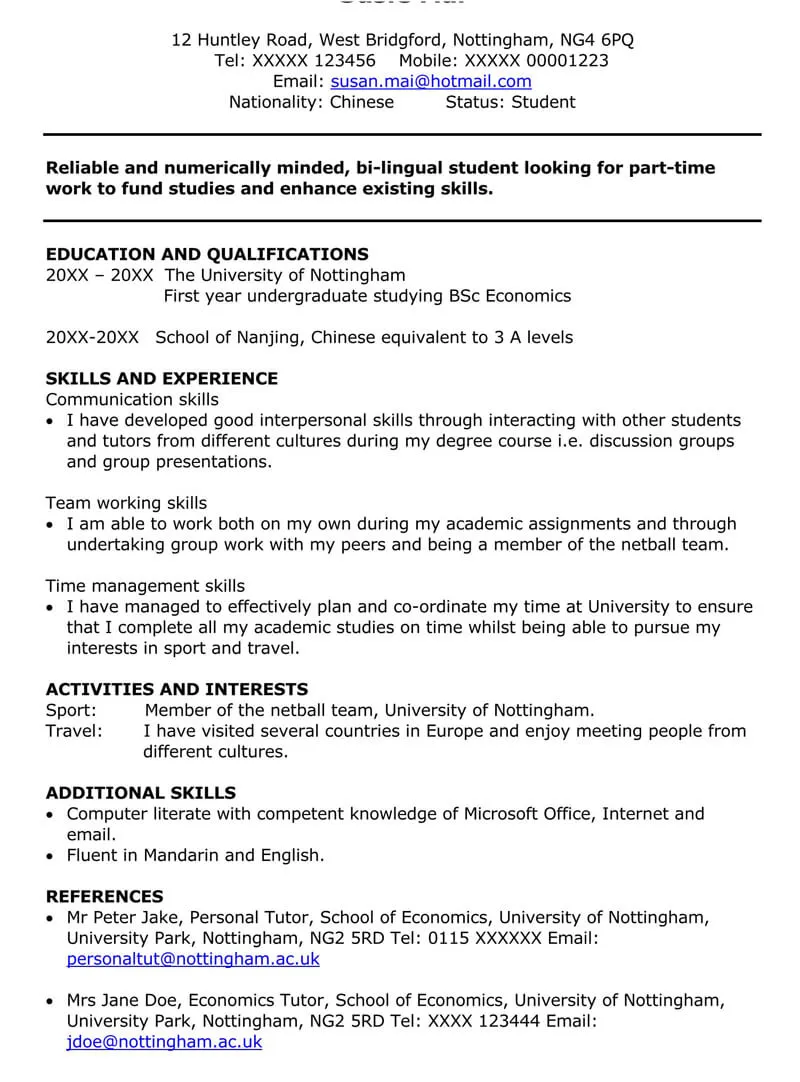
A generic cover letter rarely makes a lasting impression. The key to success is tailoring your letter to each specific job application. This shows the employer that you’ve taken the time to understand their needs and are genuinely interested in the opportunity. Start by thoroughly analyzing the job description, identifying the key requirements, and the skills and qualifications the employer is seeking. Next, review your own experience and highlight the instances where you have demonstrated those specific skills. Adjust your language and tone to match the company’s culture, demonstrating that you are a good fit. Always use the job description as your guide, and ensure that your cover letter directly addresses the employer’s needs. This level of personalization shows that you have done your homework and are genuinely interested in the position.
Analyzing the Job Requirements
Before you begin writing, carefully dissect the job description. Look for keywords that represent the required skills and qualifications. Make a list of these and use them throughout your cover letter to demonstrate that you possess the necessary abilities. Pay attention to any specific requirements mentioned, such as experience with particular software, knowledge of industry practices, or specific personality traits. Understanding these requirements is critical for demonstrating how your skills align with the employer’s needs. Make sure that your cover letter clearly addresses the job requirements and reflects the language used in the job description. This will demonstrate your attention to detail and your understanding of what the employer is looking for.
Customizing Your Letter for Each Application
Once you’ve analyzed the job requirements, customize your cover letter to reflect those specifics. Don’t simply send a generic letter with your resume. Instead, rewrite your cover letter for each application. Mention the company name, the specific role, and any details you know about the company. Highlight the experiences and skills from your resume that best match the job description, and explain how you can contribute to the company’s goals. Show the employer that you understand the role and the organization’s needs and are enthusiastic about the opportunity. A customized cover letter proves you are truly interested in the position and are not just sending out generic applications. This level of personalization significantly increases your chances of securing an interview.
Structuring Your Cover Letter Effectively
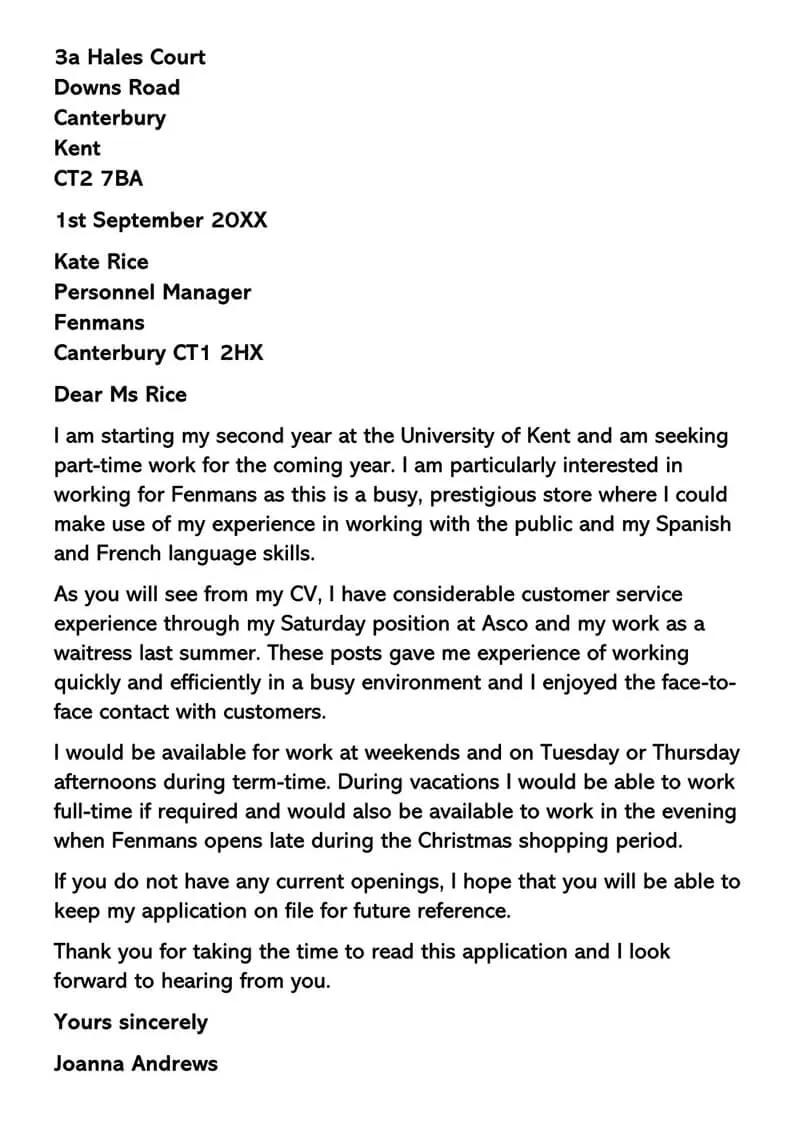
A well-structured cover letter is easy to read and highlights your key qualifications effectively. The standard format includes an introduction, body paragraphs, and a closing. Ensure your letter is well-organized, concise, and easy to navigate. Each section of the cover letter serves a specific purpose, so it’s important to understand how to structure them effectively. The introduction should grab the reader’s attention, the body paragraphs should provide compelling evidence of your skills and experience, and the closing should encourage the reader to take the next step.
Crafting a Strong Opening Statement
The opening paragraph is your chance to make a strong first impression. Start by stating the position you are applying for and how you found the job opening. Briefly mention your most relevant skills or experiences to capture the reader’s attention immediately. Express your enthusiasm for the position and the company. You can also mention something specific that drew you to the role or the organization. Avoid generic phrases such as “I am writing to express my interest.” Instead, try something like “I am excited to apply for the Part-Time Customer Service Representative position at [Company Name].” Your opening should be concise, engaging, and clearly indicate your purpose for writing.
Writing a Persuasive Body Paragraph
The body paragraphs are where you demonstrate your qualifications and highlight your relevant skills and experiences. Use these paragraphs to expand on the information in your resume. Provide specific examples of how your skills and experiences align with the job requirements. Use the STAR method to effectively describe your accomplishments, and quantify your achievements whenever possible. Focus on the benefits you would bring to the employer and demonstrate your understanding of the role and the organization’s needs. Each paragraph should focus on a key skill or experience, making your cover letter clear and compelling. The body paragraphs should be the most persuasive section of your cover letter, so craft them carefully and thoughtfully.
Creating a Powerful Closing
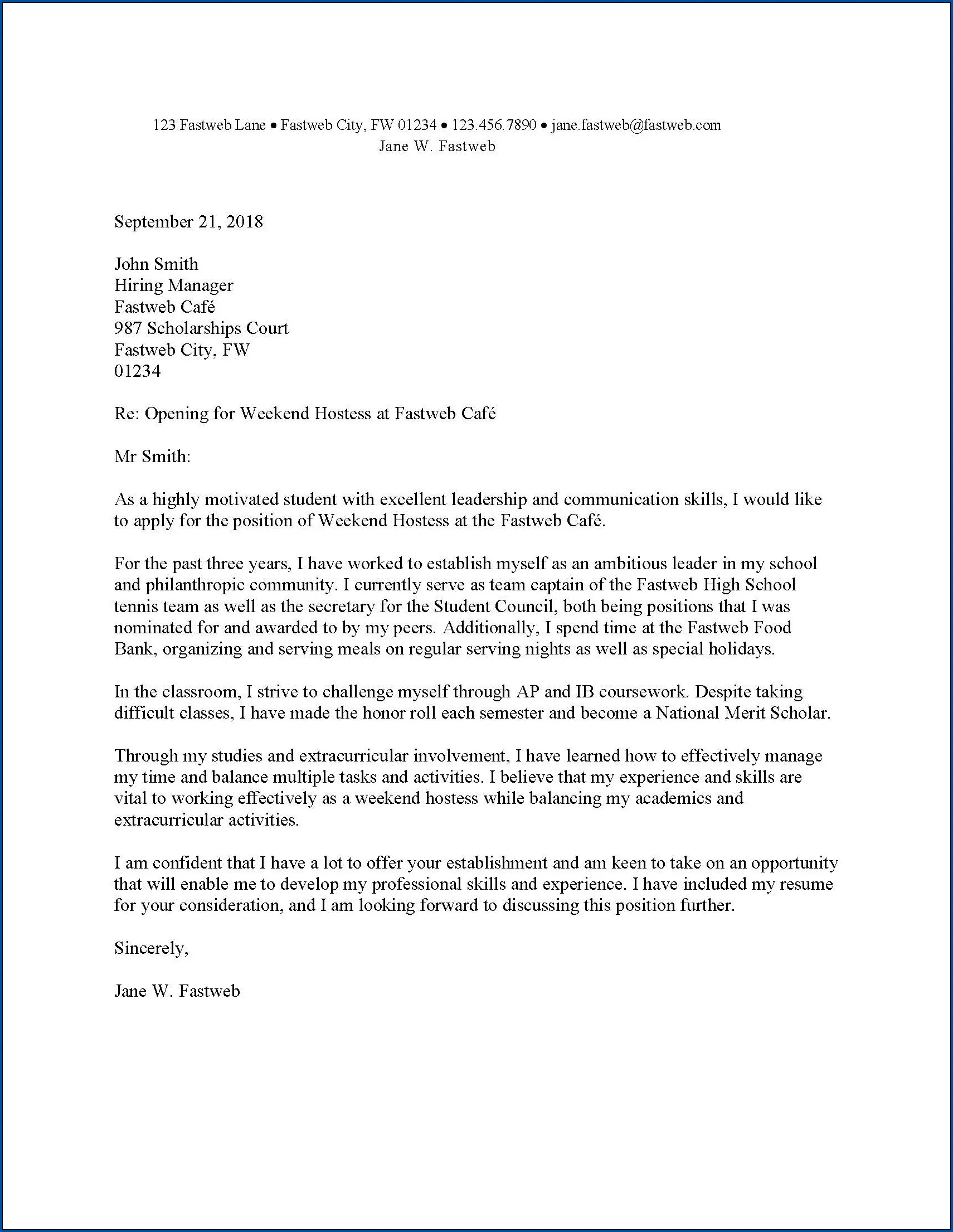
The closing paragraph should reiterate your interest in the position and encourage the reader to take the next step. Express your enthusiasm for the opportunity and thank the hiring manager for their time and consideration. State that you are available for an interview and provide your contact information. Avoid using overly formal language. End your cover letter with a confident and positive statement, such as “I am eager to discuss my qualifications further in an interview.” Review your cover letter and ensure that it’s free from errors and reflects your professionalism. The closing paragraph provides a final opportunity to leave a positive impression and increase your chances of moving forward in the hiring process.
Formatting Your Cover Letter for Readability
Formatting plays a crucial role in making your cover letter easy to read and visually appealing. A well-formatted cover letter is more likely to be read and understood by the hiring manager. Select a professional font, maintain consistent spacing, and use clear headings and bullet points to highlight important information. These formatting choices will make your cover letter more accessible and easier to navigate, helping you to get your message across effectively.
Choosing an Appropriate Font and Layout
Choose a font that is clear, professional, and easy to read. Common examples include Times New Roman, Arial, Calibri, and Helvetica. Use a font size between 10 and 12 points to ensure the text is readable without being too small or large. Maintain consistent spacing throughout your cover letter, using single or 1.15 line spacing for the body of the text and double spacing between paragraphs. Use a standard layout, such as left-aligned text with a professional header and footer. Ensure your cover letter looks clean, organized, and easy to scan, with sufficient white space to avoid a cluttered appearance. A well-formatted cover letter is crucial for making a good first impression.
Ensuring Clarity and Conciseness
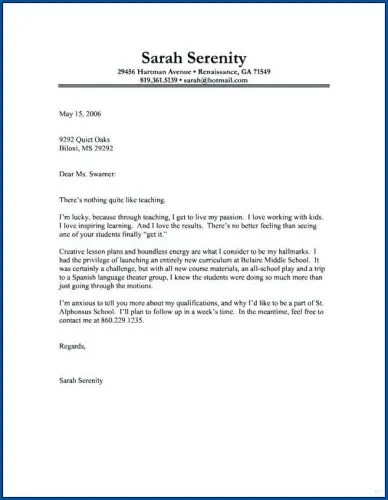
Clarity and conciseness are key to an effective cover letter. Keep your language simple and direct, avoiding jargon or overly complex sentences. Use concise language to convey your message efficiently. Get straight to the point, highlighting the most important information about your skills, experience, and enthusiasm for the role. Use active voice and action verbs to make your writing more dynamic and engaging. Ensure that each sentence contributes to the overall message of your cover letter. Avoid being repetitive or including unnecessary details. Conciseness shows that you respect the hiring manager’s time. It also makes your cover letter easier to read and understand.
Proofreading and Editing Your Cover Letter
Proofreading and editing are essential steps in the cover letter writing process. Even a small typo or grammatical error can make you appear careless and unprofessional. Take the time to thoroughly review your cover letter for any errors in grammar, spelling, punctuation, and formatting. Proofreading is not a one-time task; consider reading your cover letter several times, focusing on different aspects each time. Getting a fresh pair of eyes to review your cover letter can also be incredibly helpful. It can provide valuable feedback and catch any errors you may have missed. A polished, error-free cover letter demonstrates your attention to detail and professionalism, significantly increasing your chances of making a positive impression.
Checking for Grammar and Spelling Errors
Carefully check your cover letter for grammatical errors, such as incorrect verb tenses, subject-verb disagreements, and improper sentence structure. Use a spell checker to catch any spelling mistakes, but don’t rely on it entirely. Proofread your cover letter meticulously, paying close attention to each word and sentence. Consider reading your cover letter aloud to help identify awkward phrasing or grammatical errors. Review the punctuation to make sure it is used correctly. Make sure that the tone and style match the company culture and job requirements. A well-written, error-free cover letter demonstrates your professionalism and attention to detail, which are vital for securing a part-time job.
Getting Feedback from Others
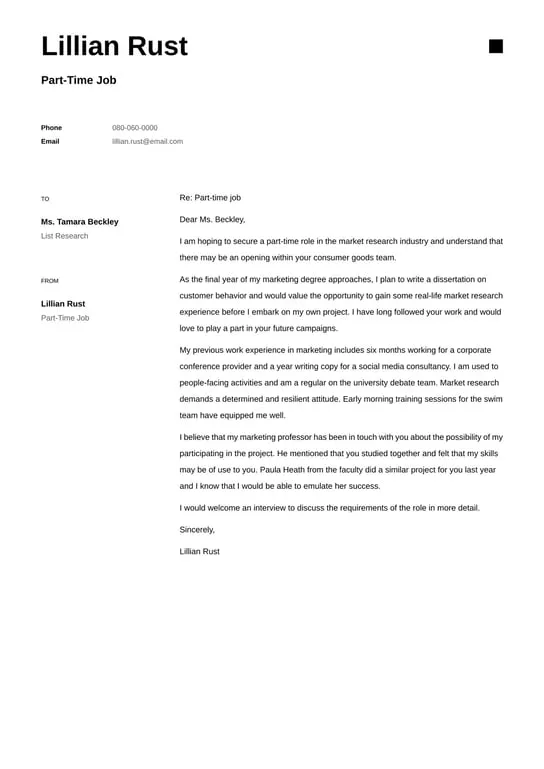
One of the most valuable steps in the cover letter writing process is getting feedback from others. Ask friends, family members, career counselors, or professors to review your cover letter and provide constructive criticism. These individuals can offer a fresh perspective and identify areas where you can improve your writing or the overall impact of your cover letter. They can also catch errors you might have missed. Ask them to focus on clarity, conciseness, grammar, and how well you’ve tailored your letter to the job description. Be open to their suggestions and make revisions based on their feedback. Receiving feedback and making revisions is an essential part of creating a compelling and effective cover letter. Use this opportunity to refine your cover letter until it is a polished reflection of your skills, experience, and enthusiasm.
Example Cover Letter Templates
Using a cover letter template can streamline the writing process and ensure you include all the essential elements. These templates provide a framework for structuring your letter and highlighting your qualifications. However, remember to customize the template to match the specific requirements of the job. Different templates can be customized for different roles, so choose the template that aligns with the part-time job you’re applying for. Replace the placeholder text with your information, experience, and enthusiasm. Modify the template to make it your own, reflecting your unique style and personality. A well-customized template can save you time and help you create an effective cover letter.
Customer Service Cover Letter Example
When applying for a customer service position, your cover letter should highlight your communication skills, problem-solving abilities, and ability to handle customer inquiries. Start by showcasing any relevant experience in customer service, such as previous roles where you interacted with customers. Provide examples of how you’ve provided excellent service, resolved customer issues, and built positive relationships. Highlight your ability to remain calm and professional under pressure. Demonstrate your patience, empathy, and ability to actively listen to customer concerns. This helps to create a compelling customer service cover letter example.
Retail Associate Cover Letter Example
For a retail associate position, your cover letter should focus on your customer service skills, sales experience, and ability to work in a team environment. Start by highlighting any previous retail experience you have, including tasks like handling transactions, stocking shelves, and assisting customers. Mention any sales achievements and your ability to meet sales targets. Showcase your communication and interpersonal skills, as well as your ability to work well with others and contribute to a positive team environment. Mention your knowledge of the products and services offered and your interest in providing excellent customer service. Make the retail associate cover letter example more appealing.
Administrative Assistant Cover Letter Example
If you’re applying for an administrative assistant position, your cover letter should highlight your organizational skills, attention to detail, and proficiency in administrative tasks. Mention any experience in managing schedules, handling correspondence, or performing data entry. Highlight your ability to use office software and equipment, and your experience in supporting administrative duties. Demonstrate your ability to handle confidential information and maintain a professional demeanor. Highlight your organizational skills, ability to manage multiple tasks, and prioritize deadlines. This all helps to show that you can handle administrative tasks efficiently. A well-crafted administrative assistant cover letter will demonstrate your commitment and suitability for the role.
Common Mistakes to Avoid
Avoiding common mistakes can greatly increase the effectiveness of your cover letter. Knowing what to avoid is just as important as knowing what to include. Many applicants make mistakes that can diminish their chances of securing an interview. Being aware of these pitfalls and taking steps to prevent them will help you create a cover letter that stands out. Avoid making generic cover letters, and tailor your letter to each specific application. Ensure your cover letter is free of typos and grammatical errors. Never ignore the job description or fail to address the specific requirements mentioned. Always include a strong call to action, and follow up on your application.
Generic Cover Letters
Sending a generic cover letter is a common mistake that can easily lead to rejection. Generic cover letters lack personalization and don’t show the employer that you’ve taken the time to understand their needs or the specific job requirements. Always take the time to tailor your cover letter to each job you apply for. Research the company and the role and highlight how your skills and experiences match their specific needs. Customize your letter by mentioning the company name, the specific role, and any details you know about the company. Avoid using general opening and closing statements. Show the employer that you understand the role and the organization’s needs.
Typos and Grammatical Errors
Typos and grammatical errors can significantly undermine your credibility. They signal a lack of attention to detail and can make you appear unprofessional. Always proofread your cover letter carefully for any errors in spelling, grammar, and punctuation. Use a spell checker, but don’t rely on it entirely. Always check for subject-verb disagreements, incorrect verb tenses, and other common grammatical errors. Ask someone else to review your cover letter as a fresh pair of eyes can often catch mistakes you’ve missed. A polished, error-free cover letter demonstrates your professionalism and attention to detail, and it will greatly increase your chances of making a positive first impression.
Ignoring the Job Description
Ignoring the job description is a common mistake that can make your cover letter irrelevant. The job description provides important details about the position’s requirements, qualifications, and desired skills. Carefully read the job description and tailor your cover letter to match its specifics. Highlight the experiences and skills that align with the job requirements, and use the keywords mentioned in the job description. Show the employer that you have a clear understanding of the role and can meet the requirements listed. Ignoring the job description can lead to your cover letter being dismissed. The goal is to demonstrate your suitability for the role, so the job description is a good resource.
Following Up on Your Application
Following up on your application shows your interest and initiative. Send a polite email or make a phone call to the hiring manager a week or two after submitting your application. This helps you to reaffirm your interest in the role and show your enthusiasm. In your follow-up, mention the position you applied for, restate your interest, and briefly reiterate your relevant qualifications. Be professional and concise in your communication. Asking about the status of your application shows your dedication. It may help you move forward in the hiring process. Your follow-up will leave a positive impression on the hiring manager.
